 |
WQXR AM 1560 |
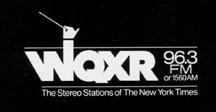 |
 |
WQXR AM 1560 |
 |
| One of my earliest and most important radio memories was hearing my two (husband and wife) piano teachers (Loretta
Poto and Bruce Hart) perform Poulenc's Piano Concerto for 2 Pianos live with the Boston Pops Orchestra. The broadcast
was simulcast in stereo: one channel on AM and the other on FM. Martin
Bookspan was the announcer. Bruce Hart was killed in an airplane crash in 1964). I'd have to say that my favorite
WQXR personality came to be George Edwards on his show "Bright and Early." I would have the radio just
before 6AM and at the stroke of six, I heard the powerful POP of the WQXR silence the noise, when, an instant later,
George would say "Well, Good Morning - This is George Edwards" - Jim Hawkins |
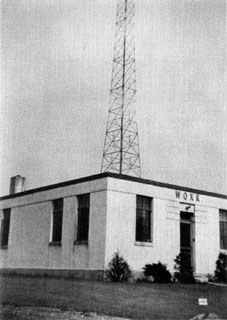 |
| WQXR began in 1929 as W2XR when John V.L. Hogan received an experimental license to send mechanically scanned images by radio on 2100KC. Hogan invented the ganged variable capacitor (many on one shaft), eliminating the need for multiple dials on radios. In the call letters, the '2' designated that the station operated in the NY/NJ region, the XR stood for eXperimental Radio. In 1933 when the Radio Commision authorized double-wide (band) 20KC channels at 1530, 1550, and 1570, Hogen decided to accompany his "television" pictures with live and recorded classical music. He took advantage of the wide bandwidth to send superior quality audio over the air (today's AM stations are confined to 10KC bandwidth, which limits the fidelity.) The image transmission experiments were eventually abandoned to focus on the best quality audio signal. |
| Hogan joined with publicist Elliott Sanger (see photo of Sanger on this page) in 1936 to form the Interstate
Broadcast Company and turn W2XR into a commercial operation. On December 3, 1936, W2XR became WQXR. The 'Q' was
chosen to resemble the sound of '2'. Most radio receivers were not capable of reproducing the quality that WQXR transmitted, so in 1937, Hogan sent engineers Russell Valentine (photos show Valentine on this page) and Bob Cobaugh to visit businesses in the Long Island City area and charge $1.00 to adjust radio sets whose dials stopped short of 1550 KC. |
(more to be added)
Historical information was obtained from "The Airwaves Of New York" by Bill Jaker, Frank Sulek and Peter Kanze, McFarland.
| Control Desk, Left to Right: Modulator Rack, Control Rack, RCA BTA-1D, 1 Kw Auxiliary transmitter (Black Racks Vintage 1936) (Source 1) |
|
| Another view of above. Four type 204 triodes are visible in the right side BTA-1D rack window. (Source 1) |
|
| Left to Right: Final Power Amplifier, Modulation Rack. (Source 1) |
|
| Left to Right: Tube Cabinet, Secondary Frequency Standard, Telephone Rack, Speech Input Equipment, and Monitoring and Measuring. (Source 1) |
| Rear view of power amplifier cabinet, showing Westinghouse 892-R, air-cooled tubes and cooling blowers. (Source 1) |
|
| Closeup of 892-R tubes. (Source 1) |
|
| Advertisement of 892-R tube, which is used in the RF Power amplifier. (Source 3) |
|
| Foreground: Ameritran Class B, 10 KW modulation transformer. Background: Ameritran, final power amplifier plate reactor (modulation choke.) (Source 1) This transformer and choke were moved to WERE in Cleveland, OH (See section below) |
|
| Rear view of control rack. (Source 1) |
(Source 5)
| (W2XR: March 26, 1929 - December 6, 1936) (WQXR: December 6, 1936 - December 1992) |
||
| 1929 1934 1936 1941 1956 |
2100KC and 1550 KC (W2XR) 1550KC 1560KC 1560KC 1560KC |
50W. |
| Russell Valentine, CE (Source 1) |
The WQXR Modulation transformer and reactor were
sold to WERE for use in their RCA BTA-5F
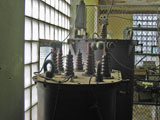 |
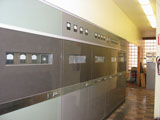 |
| John Hovanec, Market Chief of Radio One in Clevelend sent me these photos and information about the fate of
the modulation transformer and reactor from WQXR. "The backup transmitter during my tenure in the '80's was an RCA BTA-5F (yes, the 'little brother' of the 'monster' BTA-50F at 'the big 1220'). I 'cut my teeth' on that old rig in the 80's, gaining an appreciation for an old high-level plate modulated AM rig, through many an instance when it would keep the station on the air with a then tempermental AM phasor system that would 'drift'... when the then almost new 'state of the art' Harris MW-5 would not tolerate the high 'VSWR'. Anyway, it was interesting to learn at that point in time that the rig was 'modified' with 10KW 'iron' for modulation, as the less-than-robust 5kw iron that RCA designed the transmitter with was less than up to the task of +125% highly processed modulation when it was attemped in the mid 70's (prior to the Harris MW-5's arrival). I suppose these were also 'pre-Dahl Transformer' days, and pointless to attempt to replace the transformer with the same (probably very expensive) RCA type, if they were even available. From the documentation I remember seeing, and in discussions with my predesessor at the station, Jim Young, the C.E. at the time of replacement iron in the '70's - Bob Groome, was able to procure the WQXR Modulation Transformer and Reactor and install them in the WERE [AM 1300 in Cleveland] RCA BTA-5F! I have seen the documentation between Groome and WQXR C.E. dated in the 70's, as well as WQXR labeled scematic with hookup, and filing from Groome to the FCC containing documention showing 'modifications to main transmitter', etc. So I know this to be factual as to the 'fate' of the old WQXR beast's transformers." -- John Hovanec Market Chief of Radio One Note: John was our host and the CE at the time of our tour of WKNR, Clevelend. |
|
1956 dedication of the 50KW |
|
Westinghouse 50HG-2 Transmitter |
 |
An early control room with turntable. (Source 4) |
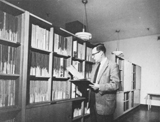 |
Section of WQXR record library. (Source 4) |
 |
Part of Kardex catalog of all the records in the WQXR library. (Source 4) |
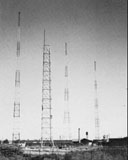 |
WQXR towers of the 50KW AM transmitter at Maspeth, LI. A fourth one is being erected in this photo. (Source 4) |
| Western Electric type 506B-2 10 KW FM Transmitter. (Source 2) |
|
| Russell Valentine, CE, Station WQXR-FM, makes initial inspections of their new Western Electric 10 KW transmitter. The transmitter is located on the top floor of the Chanin Building in midtown, New York. (Source 2) |
|
| Closeup of 3 phase full-wave rectifier tube configuration. One spare? (Source 2) |
|
| Open front of power cabinet. (Source 2) |
|
| The opened rear doors of the power supply for the 10 KW amplifier of the Western Electric type 506B-2 FM Transmitter showingl components and panel wiring. (Source 2) |
| WQXR 54A FM antenna atop Chanin Building, NY City Station WQXR-FM's "Clove-leaf" antenna is mounted atop the Chanin Building in midtown New York opposite the Grand Central Terminal. This six-bay antenna, together with the Western Electric 10 KW transmitter, provides the maximum approved ERP. (Source 2) |
|
| WQXR antenna atop Chanin Building (Source 2) |
|
| The WQXR-FM antenna atop the 54-story Chanin Building at 42nd Street and Lexington Ave. In the background, the Empire State Building where WQXR-FM transmitter was located in 1973. (Source 4) |
|
|
|
WQXR Studio. |
| Turntable with 3 tonearms (Source 6) |
|
| Harris FM 25-K Transmitter (right) Equipment Racks at the Empire State Building (Center) Continental 317-C2 (Source 6) |
|
WQXR Studio |
| Tuned in | times since April 28, 2005. |
Source 1: Harold Stein Photographers, Inc., 37 West 47th St., N.Y.C. (Peter Kanze Collection)
Source 2: Nick Lazarnick, 230 Park Ave., N.Y. (Peter Kanze Collection)
Source 3: Broadcast News Number 67, January-February, 1952, Pg. 75 (Peter Kanze Collection)
Source 4: "Rebel in Radio - The Story of WQXR" by Elliot M. Sanger 1973, Hastings House Publishers, NY
Source 5: "The Airwaves of New York" by Bill Jaker, Frank Sulek and Peter Kanze, McFarland, 1998
Source 6: "WQXR at 50 - an anniversary album" New York Times Advertising Suppliment to the New York Times
Newspaper.
All images are Copyrighted and are provided for your personal enjoyment. Use of these images for commercial
purposes including their distribution on CD-ROM or any other media without permission of the owner is prohibited.
This is a private web page dedicated to WQXR. Please visit the official WQXR page for communications relating directly to the station.